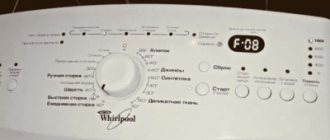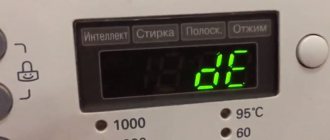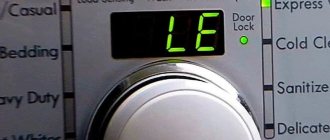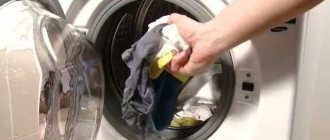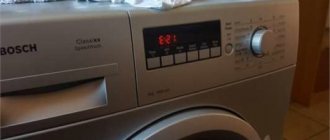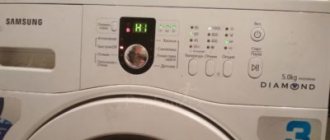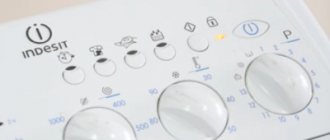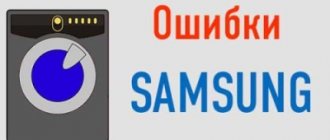All modern automatic washing machines are equipped with a self-diagnosis system and are able to detect faults as they arise. Of course, these systems differ depending on the class of the device and the brand, but the principles of operation are very similar. The owner of the device learns about the operation of the self-diagnosis system through the display or indicator, where an error code is displayed. This happens if a malfunction or incorrect operation of the main systems of the machine is detected. The code value, as a rule, is not displayed on the display, so to find out what happened to the precious device, you will have to find its instruction manual or scroll down this page and find the code value in the table. Some washing machine problems can be fixed on your own, but most problems require professional intervention.
INDESIT, ARISTON
F01 - problems with the operation of the drive motor due to a short circuit in the control circuit. F02 - there is no signal about the operation of the motor from the technogenerator to the electronic controller. F03 - there are problems with the temperature sensor. F04 - the machine indicates a malfunction of the water level sensor. F05 - problems with draining water. F06 - a signal about a malfunction of buttons in the CM series in the Ariston Dialogic line. F07 - the machine warns that the heating element is not immersed in water. F08 - malfunction of the heating element. F09 - electronic control malfunction. F10 - error in the operation of the water level sensor. F11 - there are problems with the drain pump. F12 - problems in communication between the electronic controller and the display module. F13 - drying malfunction (t0 control network is faulty). F14 - drying malfunction (drying does not turn on). F15 - drying malfunction (drying does not turn off). F17 - error in the operation of the locking lock (the door is not closed tightly). F18 - an error in the operation of the microprocessor.
Hatch door faults (ED, DC2, DC1, DC, dE2, dE1,dE)
During the washing process, the hatch door of the washing machine must be tightly closed. If this does not happen, then you will see the following symbols on the display: ED, DC2, DC1, DC, dE2, dE1, dE.
The door locking problem is one of the most common malfunctions: first of all, you should check the operation of the locking mechanism itself
The reasons for their appearance are as follows:
- the hatch door is not closed tightly enough;
- the hatch locking mechanism has failed;
- the door was displaced during the boiling process;
- they tried to open the hatch using force and damaged it;
- The sunroof lock connector was installed incorrectly;
- the sunroof sensor turned on spontaneously during the vibration of a working machine;
- An error has occurred in the control module.
Before contacting the workshop, you should find out whether the error codes appeared due to the door not being closed well enough. To do this, open the hatch and then slam it shut again. You need to check whether any debris or a corner of dirty laundry has gotten into the locking device. If these measures do not lead to the desired result, you should call a specialist.
CANDY
E01 - problems with the door locking device. E02 - a signal about water supply problems: its level does not reach or exceeds the norm. E03 - problems have arisen in the water drainage system. E04 - the machine signals a malfunction of the water filling system: its level exceeds the norm. E05 - problems with the temperature sensor, no water heating. E07 - signal about a problem with the drive motor (technical generator is faulty). E09 - malfunction of the drive motor (the shaft does not rotate).
Problem with device overheating: EE
If your Samsung SMA is not equipped with a drying device, for example, the Diamond wf8590nmw9 or 1061 model, then you may not see a code such as “EE”.
If the machine has a convenient function of thermal drying of already washed clothes, then the cause of overheating may be the same failed temperature sensor, but only of the drying device or a breakdown of its heating element. Also, on Samsung machines, error codes related to overheating can occur due to a broken internal wiring circuit.
ASKO
E01, Motor fault - errors in the operation of the drive drive. E02, Water inlet fault - a signal about problems with water intake. E03, Draining fault - there are problems in the water drainage system. E04 - the machine signals that it cannot supply enough water. E05, E06 - problems with water heating. Door lock fault - the washing machine door is not closed tightly. Floaming - increased foaming. Overfilling, Over flov - overflow of water in the washing machine tank. Termistor fault - temperature sensor operation error. Pressure sensor error - the water level sensor is faulty.
Errors in water supply (E1, 4C2, 4C, 4E2, 4E and 4E1)
Do not confuse the lack of water in the car with the fact that information about its availability has ceased to be received. We have already talked about information and the sensor above, but real problems with filling the unit with water cause the following codes to appear: E1, 4C2, 4C, 4E2, 4E and 4E1.
If water does not enter the washing machine, be sure to check the permeability of not only the hose, but also the water supply inlet valves
So, if it is impossible to fill the unit with water, then such a breakdown may be caused by the following reasons:
- there was an emergency situation in the house, as a result of which the cold water supply was completely cut off;
- the water supply hose is pinched, bent or clogged with something;
- a clogged filter element no longer allows liquid to pass through;
- the contacts have oxidized or the water supply assembly was not performed according to the rules;
- the protective function for the hose – Aquastop – has been activated;
- When connecting the washing machine, hot water was accidentally supplied to the pipes instead of cold.
An effective solution to a problem depends entirely on the cause that caused it. First of all, you need to check whether there is cold water in the house. To do this, open the tap, for example, in the kitchen.
Check whether the tap to the hose supplying liquid to the washing machine is open. If kinks or blockages are found, they should be removed immediately. If broken parts are found, they are replaced with serviceable ones.
KAISER
E01 - no signal to close the hatch: the washing will be stopped. E02 - the machine signals that the tank filling time has exceeded 2 minutes. At the same time, the system continues washing. E03 - water drainage exceeded 1.5 minutes. E04 - the machine signals a problem with water filling (tank overflow). At the same time, the system stops washing and turns on the drain pump. E05 - water filling problem. If after 10 minutes there is no signal from the “Nominal level” sensor, the machine stops washing. E06 - problem with drainage. If after 10 minutes there is no signal from the “Empty Tank” sensor, the machine stops washing.
E07 - water leakage into the pan. E08 - the power supply parameter does not correspond to the norm. Manufacturers recommend a voltage of 190–253 volts. E11 - a malfunction in the hatch lock has been detected. E21 - error in the operation of the drive mechanism system. The wash stops. E22 - the drive motor rotates on its own, without a start command. E31 - temperature sensor malfunction (most likely, this was preceded by a short circuit in the circuit). E32 - temperature sensor malfunction (open circuit). E42 - malfunction, the hatch was blocked within 2 minutes after washing.
Problems with draining water: E2, 5C or 5E
Of course, in order not to ask questions about what to do if software errors occur, you should adhere to operating standards. A malfunction is not always our fault, especially when it comes to drainage. If you see code E2 on the screen, this means that the unit cannot drain water.
This problem occurs for the following reasons::
- The drain hose is clogged with a foreign object or is pinched.
- The pump is broken.
- External blockage in the sewer.
- Electrical conductivity is impaired.
ELECTROLUX, ZANUSSI
E11 - the machine has detected a problem with water filling. E13 - water leakage in the washing machine tray. E21 - problems with draining: water was not removed from the tank within 10 minutes. E23 - the machine signals a breakdown of the triac (control element of the drain pump). E24 - problems with draining: the system has detected a malfunction in the triac circuit of the drain pump. E33 - inconsistent operation of water level sensors. E35 - a problem with water filling has been detected. The water level in the working tank exceeds the norm. E36 - failure of the sensor, which warns that the heating element is turned on if the required amount of water is not available. E37 - a malfunction of the water level sensor I was detected. E39 - malfunction of the water overflow level sensor.
E41 - the washing machine door is not closed tightly. E42 - the system has detected a malfunction of the hatch lock. E43 - malfunction of the locking lock triac. E44 - the system has detected a breakdown of the hatch closing sensor. E45 - malfunction in the hatch lock control circuit (in the electronic controller). E51 - failure of the drive motor, which was preceded by a short circuit in the control element - triac. E52 - there is no contact between the electronic controller and the tachogenerator. E53 - malfunction of the drive motor control circuit. E54 - malfunction of one of the two contact groups of the reversing relay of the drive motor.
E61 - the temperature regime is violated, the water does not reach the temperature set by the program. E66 - the system has detected a malfunction of the heating element relay. E71 - malfunction of the temperature sensor (increased resistance). E82 - the system has detected problems in the operation of the selector (a special device for selecting programs and cycles). E83 - the system detected an error when reading data from the selector. E84 - washing machine configuration error.
Imbalance error codes: E4, UE or UB
As a rule, an imbalance in a washing machine can be caused in several ways, which in the future will incorrectly affect the entire operation as a whole. This usually happens due to improper installation; it is not level, on a slippery or curved surface.
The cause of the resulting imbalance may be your items that were not sorted correctly, which after washing have bunched up into one lump that is too heavy for the machine to handle. Due to the imbalance, the machine may stop spinning things and you will most likely see the code “E4”, “UE” or “UB” on the display.
HANSA
E01 - there is no control signal for closing the door.
E11 - malfunction in the triac of the door lock power circuit. E02 - the tank fills with water to the desired level in more than two minutes. E05 - the tank fills to the desired level in more than ten minutes. E03 - water drain time exceeded 1.5 minutes. E06 - 10 minutes have passed since the water was drained, but the pressure switch does not give the “tank empty” signal. E09 - during the spin cycle, too much foam arose, which could not be removed. E04 - signal that the tank is full of water. E31 - short circuit in the temperature sensor. E32 - break in the temperature sensor. E21 - drive motor blocked. EOB - power supply parameters are violated. E22 - signal that the drive motor rotates without a command. EO7 - the AquaStop water sensor detected a water leak into the pan. E42 - the program is completed, but the door remains locked for more than two minutes. E52 - memory failure. It’s so good to have a cheat sheet that will help you out. Now you know what to do if your washing machine gives an error. Save the article so as not to lose it. Good luck!
How to reset a washing machine error
If it was not possible to automatically reset the washing machine error after restoring functionality, you can do this manually. To do this use:
- "Start/Pause" button . Activate it and hold it until the indicators start flashing or a beep sounds. Usually this technique helps remove the error from the monitor.
- Test mode . If you cannot remove the inscription and lock using the buttons, use the testing function. How to run the program can be seen in the instructions, which describe the reset sequence.
Resetting an error using the Start/Pause button
